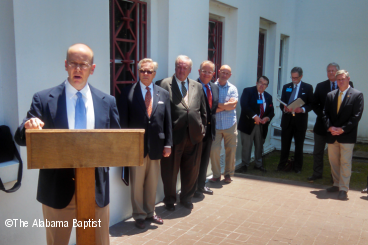There is both wide-open opportunity and intense opposition to evangelism in Mexico.
Where each is found depends largely on what part of the country missionaries find themselves in.
“There is an openness many places in Mexico that indicates that this is a strategic moment to move forward through doors the Lord opens,” said Elbert Smith, former International Mission Board (IMB) regional strategy associate for what is now the Middle America and Caribbean region.
Though need for the gospel exists everywhere in Mexico, Smith explained that one area of the country phenomenally lacking the gospel is the six states in west-central Mexico, an area he calls Mexico’s “Heart of Darkness.”
Two years ago, Smith said, “Although this area includes intense levels of lostness, it has also seen the fastest percentage of growth of any part of Mexico in the last 10 years,” Smith said.
“Now is the time to send more missionaries, more gospel saturation teams and more prayerwalking teams. Now is the time to move forward.”
But even now, two years later, the need still exists in the “Heart of Darkness,” according to one National Woman’s Missionary Union (WMU) official. Joanne Parker, WMU adult missions studies editor and Missions Moasic magazine editor, said one aspect of the 2004 WMU International Missions Study focuses on this area of great need.
“There are so many people lost in the ‘Heart of Darkness,’” she said. “Missionaries who work there say there might be three Christians among 1,000 people.”
Neil Treme supervises missionaries as they develop a strategy to start new churches in every town and city in an area where less than two percent of the population is evangelical.
Treme said that in the “Heart of Darkness” about 97 percent of the people are Catholic (see story, page 7).
According to the CIA World Factbook, only 6 percent of Mexico’s total population are Protestant. By comparison, China is only 3–4 percent Christian and the United States is 56 percent Protestant.
Mexico, for the most part, is hungry for the gospel. This, along with more religious freedom, means that evanglicals have greater opportunity than ever before.
Treme said churches are beginning to grow and multiply in parts of the country.
A free trade agreement helped begin this in 2001.
“Many places in the north and central part of Mexico [saw] new employment opportunities due to North American Free Trade Agreement (NAFTA). These workers often moved from other parts of the country and were more open to the gospel in a new setting,” Smith said.
Near the same time the Mexican government began its push to become more open with trade through NAFTA, it began to open doors to missionaries by lifting many restrictions. In 1992, changes in Mexico’s constitution opened up better governmental treatment of religious minorities. The changes meant that missionaries were officially permitted to work in the country.
Registered evangelical churches also gained the legal right to evangelize, establish new churches, purchase and own property, hire pastors and staff and invite international missionaries to minister with them, according to Central American Mission (CAM) International, a Dallas-based Christian organization specializing in taking the gospel to Spanish-speaking people.
Before these changes, missionaries had to enter the country on tourist visas, or obtain permanent visas for reasons other than missionary work. “Never before in the history of Mexico has there been more freedom to evangelize and plant churches,” CAM stated.
After forming in 1890 and spreading into various Spanish-speaking countries, CAM first began planting churches in Mexico in 1955.
Today, scores of CAM missionaries give themselves to evangelism, church planting, leadership training, radio broadcast, publishing Christian literature, educating missionary children and Bible translation.
Even with the wide-open doors to missionaries, much persecution of people attempting to spread the gospel exists, especially in southern parts of Mexico. Despite challenges to evangelization and church planting, Mexican Christians have big goals to evangelize and provide growth opportunities for their churches.
Under the leadership of Gilberto Gutierrez, the president of the National Baptist Convention of Mexico, the convention has the goal of reaching 1 percent of Mexico with 10,000 new churches by 2010. The IMB is working with the national convention to help make this goal a reality.





Share with others: